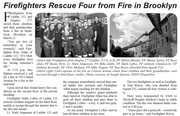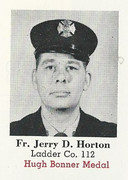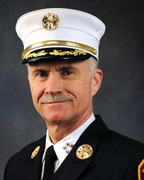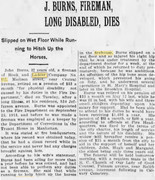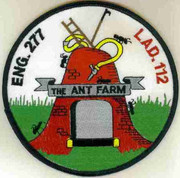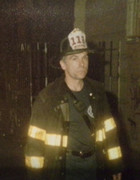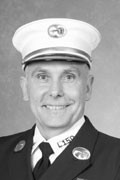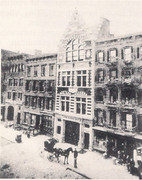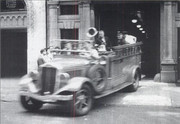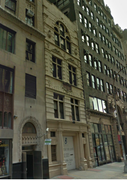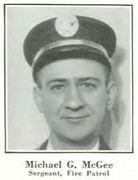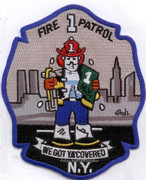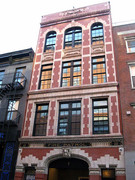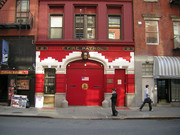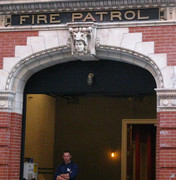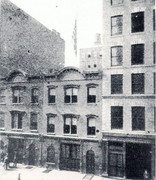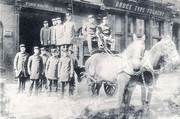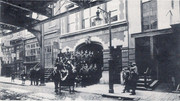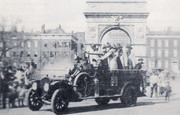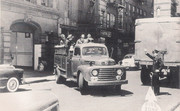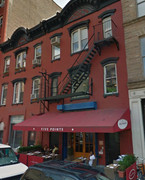NY Fire Patrol 3 (later Fire Patrol 1) firehouse 240 W 30th Street
Daytonian in Manhattan
Thursday, September 20, 2012
The 1894 Fire Patrol #3 -- 240 West 30th Street

photo by Alice Lum
In 1839 the New York Board of Fire Underwriters was established as an outgrowth of the Mutual Assistance and Bag Corporation which had been formed 36 years earlier. The insurance companies sought to prevent or at least reduce the loss of property caused by fires. Claims by merchants for lost inventory were often due to water damage caused by the fire department as much as by the fire itself.
When the Board of Fire Underwriters added actual fire fighting to its methods of preventing losses to insured property, the Fire Patrol was established. The Fire Patrol was a private organization, distinct from the Fire Department. The Patrol would rush to a fire working side-by-side with fire fighters, laying tarps to protect goods from water , removing goods when possible, and all the while fighting the flames.
The Fire Patrolmen became recognizable by their bright red helmets. In 1858, with still just two Fire Patrol Companies in New York, an order dictated ?Resolved?That the men belonging to the Fire Patrol be required immediately at their own cost, to have their fire caps painted a bright red color, and have front pieces furnished with the words, ?Insurance Patrol No. 1? for the lower district, and ?Insurance Patrol No. 2? for the upper district, together with the initials of the wearer of the cap legibly painted thereon to be white, with black letters as above.?
The success of the Fire Patrol resulted in a third company being formed. In 1894 a new fire patrol house at No. 240 West 30th Street in the crime-ridden Tenderloin district began rising. When the Board of Underwriters hired the architectural firm of D?Oench & Simon to design the building, the choice was obvious. Albert F. D?Oench served as an instructor in the first fire fighter training school when it opened in 1892, and was the Superintendent of Buildings.
At the time a renewed interest in the Dutch heritage of New York resulted in the appearance of Flemish Revival buildings throughout the city, especially on the Upper West Side.
D?Oench & Simon turned to this style for the new Patrol Company No. 3. Completed in September 1895 it rose four stories to an elaborate stepped gable and peaked roof covered in Spanish tile. The ground floor was clad in Indiana limestone and the upper floors were a cream-colored brick. Terra cotta ornamentation included window pediments that changed with each successive floor.

The original stepped gable and Spanish-tiled roof. - The New York Times September 11, 1895 (copyright expired)
The new patrol house was opened with a large ceremony on the evening of September 10, 1895. The Sun reported that ?Hundreds of guests of the Fire Patrol Committee of the New York Board of Fire Underwriters viewed the building.? It was a model of up-to-the-minute technology and conveniences.
There were accommodations for twenty-six men on the second floor, ?each of whom has a separate brass bedstead and a clothes closet,? reported The New York Times. Here too was the private office of the captain. Five sliding poles pierced the floor to enable the patrolmen to rapidly respond to the alarm. One especially clever innovation was the short pole for the driver, located near his bed. When the driver slid down this brass pole, it dropped him conveniently into the seat of the waiting wagon.
The third floor included a billiard room and a sitting room for the patrolmen, as well as the superintendent?s office. ?Throughout the building great care has been taken to provide for the comfort and convenience of the men,? said The Times. The top floor was designated for workshops and the supply room. Racks for drying the tarps lined the ceiling.
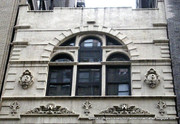
Ornate medallions are emblazoned with F and P for Fire Patrol -- photo by Alice Lum
Five horses and two patrol wagons?with improved apparatus for quickly reaching fires, said The New York Times--were housed on the first floor. Behind the station was a two-story brick building with feed rooms and a hayloft. ?Here are two large box-stalls with a thick flooring of Irish peat, where the horses in turn are allowed a chance to recover from hard runs,? said The Times.
The Weekly Underwriter praised the design. ?It is a model of completeness for the purposes for which it was constructed and is equipped with every known device and improvement for comfort of the men and the uses of the business.? Like the Times reporter, the writer was impressed with the conveniences. ?The floors of the office, toilet and bath rooms are made of marble and mosaic, the stalls have asphalted floors, each stall being separately drained; the entire building is piped for gas and electric light?the building is heated by steam.? Even more impressive was the electric elevator in the rear of the building ?for passengers or freight.?

Before being thoughtlessly covered in white paint, the terra cotta and ornamental cast iron masonry supports would have been an attractive contrast to the light-colored brick -- photo by Alice Lum
The 26 men of Fire Patrol No. 3 had an immense territory to cover?from river to river and from 14th Street to 57th Street. But on the morning of June 18, 1901 the men did not have to travel far. The tenement building at No. 441 West 31st Street was on fire. Rather than evacuating the burning building immediately, one tenant, Mrs. O?Hagan, took the time to gather up her money and some valuables and then became trapped. The New York Tribune reported that ?She is a fat woman and was unable to get down the fire escape. She stood at the window threatening to jump, two of her children, a boy and a girl, beside her.?
Hook and Ladder Company No. 24 was fighting the blaze and Fire Patrol Company 3 was working alongside. When Fire Patrolman Cunningham and Fire Lieutenant Kehoe found her, Mrs. O?Hagan was hanging out of the window. Using a short ladder they reached the fire escape and passed the two children down. But as their portly mother started down, there was a problem. The ladder slipped loose from its fastenings.
Fire Patrolman Cunningham caught the portly woman by her wrist and held her dangling three stories above the sidewalk until the lieutenant could get the ladder secured. ?Then she was brought down safely,? said the Tribune, ?Her wrist was sprained.?
Along with the 26 fire patrolmen, the captain and the superintendant, Willie was in residence at No. 240 West 30th Street. Willie was a goat. And on February 19, 1903 Willie noticed that the stable door was ajar and he decided to explore the city. As the goat wandered to 6th Avenue a group of boys followed him, some throwing snowballs. Willie, apparently not enjoying the sport, charged the group, knocking one boy down. He moved on to fashionable 5th Avenue.
?The real excitement began there,? reported The New York Tribune. ?The goat was not used to such bewilderment of vehicles, and he had difficulty in dodging them. The horses were not used to seeing goats running loose in New York?s fashionable thoroughfare, and they pranced and danced, none caring to come in contact with Willie.?
Carriages carrying wealthy residents were rocked and several pedestrians were knocked down by the rampaging goat. ?Soon the avenue was in a tumult,? said the newspaper. A crowd of hansom cab drivers and boys with sticks and other weapons attempted to corral the goat. Willie ran to the private entrance to the exclusive Waldorf-Astoria Hotel and the mayhem continued when porters tried to remove him and one was knocked down.
Willie?s adventure came to an end when he simply returned to the stable. ?No one had been seriously injured,? comforted The Tribune.
Prospective fire patrolmen were carefully screened. Because they were constantly in contact with the valuable goods they were trusted to protect, a dishonest patrolmen was definitely not wanted. However in 1909 the Board of Fire Underwriters took a chance on Joseph Carmichael. The man had been in the Catholic Protectory and the House of Refuge ?as an incorrigible,? said The Sun, and on June 3 he had been convicted of stealing $60 worth of jewelry and $30.50 in cash from Charles W. Gould. But his sentence had been suspended and he was accepted as a fire patrolman.
Unfortunately, becoming a fire patrolman did not chance his habits. Three days before Christmas that year Carmichael stayed back while the company rushed to a fire. When the men returned, David H. Drought noticed his gold watch and chain was missing from his locker. Carmichael confessed and was arrested, promising to return the watch.
The arresting detective waited while Carmichael received the 14-pound turkey that the Board of Underwriters gave to every fire patrolman for Christmas. They then proceeded to his mother?s house on Lexington Avenue. Mrs. Carmichael received a Christmas turkey, Fire Patrolman Drought received his watch, and Carmichael received a jail sentence.
Throughout the years Fire Patrol No. 3 continued to go beyond the mere protection of insured goods from water and fire. On September 22, 1915 a massive explosion in the nearby 7th Avenue subway resulted in the collapse of the street for blocks. Subway passengers were trapped beneath the rubble and dozens of motorists and pedestrians fell into the chasm including a passenger-filled trolley car.
?Lieut. John Sanders, Sergeant John Butler and the six men of Fire Patrol No. 3 did heroic work in getting out injured and frightened persons,? reported The Sun. ?When they arrived they had no long ladders, so used ordinary scaling ladders and ropes. They gave first attention to the trolley car, from which there were rising cries for help.?
In 1916 Irving Crump supplied an eye witness account of the dangers the Fire Patrol encountered. ?White coated men wearing red fire helmets were working about in the glare of the rays from the searchlight engine. I learned later that they were the men of the Fire Patrol, and that they were busy saving property in the warehouse.
?When I arrived, several of them were rolling huge blue barrels, that looked like oil containers, through one of the doorways of the building. They seemed to be working madly, and firemen were helping them. In and out of the building they hurried, plunging through smoke so dense that I wondered they could go through it and remain alive. Now and then one staggered back, coughing and choking, only to master himself with an effort and plunge back into the smoke again.?
When Crump asked what the patrolmen were doing, he was told that there were barrels of gasoline and motion picture film in the building which presented a potential disaster. But even as the explanation was being given, the worst of the patrol?s fears became reality?the remaining gasoline barrels exploded.
?Out through the doorways staggered the men of the Fire Patrol and the firemen who had been operating lines inside the building,? said Crump. ?Some of them seemed literally blown into the street by the force of the explosion.?
The same year Sergeant William S. Cashman was on the scene of a fire at No. 347 West 38th Street. Fireman Harry J. Murphy of Engine Company No. 26 fell through the floor, landing unconscious in the cellar of the burning building. Cashman rushed in, pulling the fireman to the safety of the street, saving his life. A year later he was awarded the Fire Underwriters? life saving medal. The gold medal ?goes only to those who have performed feats of signal bravery,? said The Sun.
The unit was later renamed Fire Patrol #1 and at some point during the 20th century the handsome Flemish Revival gable and peaked roof were removed, to be replaced by a stepped parapet and flat roof. The building was decommissioned in 2006.
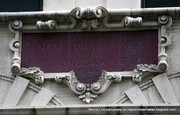
photo by Alice Lum
Today the first two floors, where fire patrolmen slid down brass poles and horse-drawn wagons awaited the alarm, are home to a nightclub. And although someone thought it would be a good idea to cover the brick, terra cotta and limestone with white paint, the building retains its handsome architectural integrity?even with the loss of the wonderful gable.
http://daytoninmanhattan.blogspot.com/2012/09/the-1894-fire-patrol-3-240-west-30th.html

